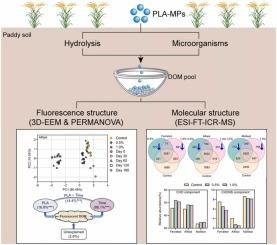聚乳酸微塑料对不同土壤类型的溶解有机质的影响:对分子组成的见解
IF 11.3
1区 环境科学与生态学
Q1 ENGINEERING, ENVIRONMENTAL
引用次数: 0
摘要
越来越多的证据强调了可生物降解微塑料(MPs)对土壤有机质(SOM)的影响,但土壤类型和孵育时间的作用尚不清楚。本研究考察了聚乳酸微塑料(PLA-MPs)对三种水稻土(Ferralsol、Alfisol和Mollisol)中溶解有机质(DOM)的数量和分子组成以及培养时间的影响,揭示了DOM转化的土壤特异性模式:PLA-MPs使Ferralsol和Alfisol中的DOM含量分别降低29.3 ~ 68.2 mg/kg和27.3 ~ 30.9 mg/kg,但在Mollisol中DOM含量最初增加(30 d: 220.9 mg/kg;60 d: 622.0 mg/kg)。分子分析显示,在30和180 d时,DOM成分多样性都有所减少,这可能是由于PLA-MPs刺激微生物活性,加速了天然SOM的分解。PLA-MPs促进CHO(含碳(C)、氢(H)和氧(O))化合物的形成,而微生物选择性地分解CHONS(含C、H、O、氮(N)和硫(S))化合物以满足C和N的需求,特别是在Ferralsol和Alfisol中。本研究加强了对可生物降解MPs对SOM的影响的理解,强调了土壤性质的作用。本文章由计算机程序翻译,如有差异,请以英文原文为准。

Effects of polylactic acid microplastics on dissolved organic matter across soil types: Insights into molecular composition
Increasing evidence has highlighted the effects of biodegradable microplastics (MPs) on soil organic matter (SOM), but the role of soil type and incubation time remains unclear. This study investigated the effects of polylactic acid microplastics (PLA-MPs) on the amount and molecular composition of dissolved organic matter (DOM) across three paddy soil types (Ferralsol, Alfisol, and Mollisol) and incubation times, revealing soil-specific patterns in DOM transformation: PLA-MPs reduced DOM content in Ferralsol and Alfisol by 29.3–68.2 mg/kg and 27.3–30.9 mg/kg, respectively, but initially increased it in Mollisol (30 d: 220.9 mg/kg; 60 d: 622.0 mg/kg). Molecular analyses revealed a decrease in DOM component diversity at both 30 and 180 d, potentially due to PLA-MPs stimulating microbial activity and accelerating native SOM decomposition. PLA-MPs promoted the formation of CHO (containing carbon (C), hydrogen (H), and oxygen (O)) compounds, whereas microbes selectively decomposed CHONS (containing C, H, O, nitrogen (N), and sulfur (S)) compounds to meet C and N demands, particularly in Ferralsol and Alfisol. This study enhances the understanding of biodegradable MPs’ impact on SOM, emphasizing the role of soil properties.
求助全文
通过发布文献求助,成功后即可免费获取论文全文。
去求助
来源期刊

Journal of Hazardous Materials
工程技术-工程:环境
CiteScore
25.40
自引率
5.90%
发文量
3059
审稿时长
58 days
期刊介绍:
The Journal of Hazardous Materials serves as a global platform for promoting cutting-edge research in the field of Environmental Science and Engineering. Our publication features a wide range of articles, including full-length research papers, review articles, and perspectives, with the aim of enhancing our understanding of the dangers and risks associated with various materials concerning public health and the environment. It is important to note that the term "environmental contaminants" refers specifically to substances that pose hazardous effects through contamination, while excluding those that do not have such impacts on the environment or human health. Moreover, we emphasize the distinction between wastes and hazardous materials in order to provide further clarity on the scope of the journal. We have a keen interest in exploring specific compounds and microbial agents that have adverse effects on the environment.
 求助内容:
求助内容: 应助结果提醒方式:
应助结果提醒方式:


